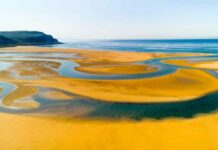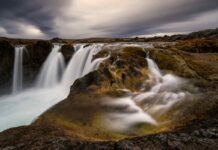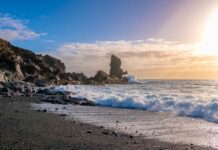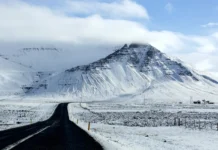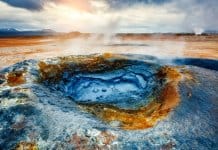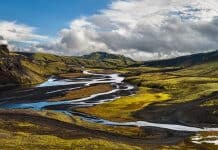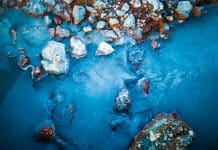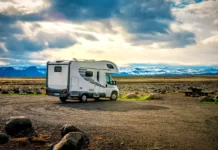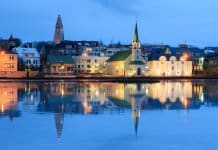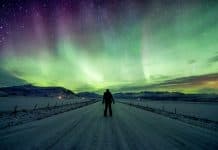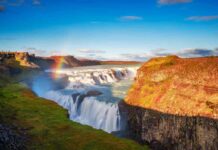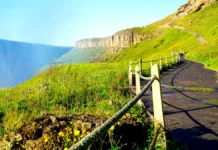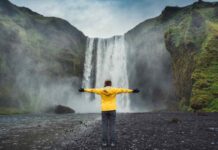Iceland in January is a magical time. The country’s legendary landscapes are blanketed in white snow like a virtual winter wonderland. Waterfalls freeze and are stopped in time in a state of suspended animation. And Vatnajökull’s sparkling turquoise glacier caves are ready for you to explore their cavernous depths. It’s no wonder many consider January to be one of the best months to visit Iceland. The crowds of summer have left, making you feel as though you have the island to yourself. And lower prices make the proposition of an Iceland winter vacation even more enticing. As you can imagine, the weather will have a huge impact on your trip, regardless of the time of year. January itself presents its own set of challenges, from low temperatures to heavy snowfall to reduced daylight hours. Let’s take a look at all of these factors to help prepare for and plan your trip.

Average Temperatures in Iceland in January
It’s important to know the degree of coldness you’ll be dealing with during your Nordic escapade. The good news is that Iceland is not as icy as you might think. Yes, there’s definitely snow on the ground. But you won’t have to wear multiple, thick layers and a fur-lined anorak just to prevent frostbite when you step outside. I’ve often seen people compare Iceland’s January weather to winter in New York. It’s cold but not polar. This is thanks to the Gulf Stream. The warm ocean current crosses the Atlantic from the Gulf of Mexico and brings warm waters to the island. As a result, Iceland is much warmer than you might think, given its far northern, sub-Arctic latitude.
The average high in Reykjavik in January hovers around 37 ºF (3 ºC). With the average low, the mercury reading on the thermometer dips to about 27 ºF (-3 ºC). There are of course some notable exceptions. On certain days on parts of the island in January of last year, highs reached 46 ºF (7.7 ºC). Lows got down to a bitter cold of just 14 ºF (-10 ºC).
Average High in Reykjavik: 37 ºF (3 ºC)
Average Low in Reykjavik: 27 ºC (-3 ºC)
January Snowfall and Precipitation in Iceland
January is the wettest month of the entire year in Iceland. Because temperatures are constantly close to the freezing point of water, the 50 mm of monthly precipitation often takes the form of snow, sleet, or hail. In addition to lots of wind, all of this wet weather means you need to dress well. Having a waterproof, windproof shell layer on top of two base layers and an insulating layer is key. The four-layer rule will keep you warm and dry while taking a boat ride around Jökulsárlón glacier lagoon or getting up close and personal with Iceland’s beastly Dettioss waterfall. Knowing what to pack and wear in Iceland in January is an important part of enjoying your trip.

Driving in Iceland in Winter
Lots of falling snow and icy roads mean that when driving to famous sights like the Snaefellsnes peninsula or along the Diamond Circle Route, you need to take extra precautions. You’ve already got lots of gravel roads and dangerous driving conditions all over the country. Factor in slippery, slick surfaces and you’ve got a hazardous cocktail. Take your time getting to where to want to be. In Iceland, it really is about the journey rather than the destination. Check with your rental company to make your car or camper comes fully-equipped with snow tires at a minimum. It’s also smart to stay current on weather updates using the Iceland Meteorological Office website and the Icelandic Road and Coastal Administration website. They provide warnings and advisories about road conditions and winter snowstorms that could hinder your travel plans.
Reduced Daylight Hours in January
The last thing I want to mention is the number of daylight hours Iceland receives in the winter. It’s true that at this time of year, things are quite dark for a large part of the day. With the sun rising as late as 11:20 am and setting as early as 3:45 pm, it doesn’t leave much time for winter activities. You’ll need to plan your outings carefully to make sure you can fit in all the excursions you want to do. And if you’re someone who doesn’t like driving when it’s dark outside, it’s even more important to time things correctly.
You’ll definitely want to take advantage of civil twilight. As you know, the sky is not pitch black right after the sun sets (or before it rises). Civil twilight is that extra hour or two of light that you have when things aren’t 100% dark. January’s civil twilight starts between 9 am and 10 am and ends between 5 pm and 6 pm. So yes, Iceland gets dark in January, but much like the cold, the lack of sunlight is probably not as bad as you thought.
Beginning of January: Sunrise – 11:19 am | Sunset – 3:43 pm
Middle of January: Sunrise – 10:55 am | Sunset – 16:19 pm
End of January: Sunrise – 10:12 am | Sunset – 17:11 pm

What to Know About Iceland’s January Weather: Temperatures, Snowfall, Daylight
Knowing what to expect during your Iceland trip in January will go a long way in helping you enjoy your time here. The weather needs special treatment when it comes to what you pack and wear and how you approach driving. That being said, the winter opens up a whole host of cool outdoor activities that you couldn’t do if you had visited in the summer. From glacier hikes and snowmobile rides at Skaftafell to skiing and snowboarding in Dalvik, January means something different for everyone. Remember to pack lots of warm layers along with your sense of adventure. You won’t be disappointed.

